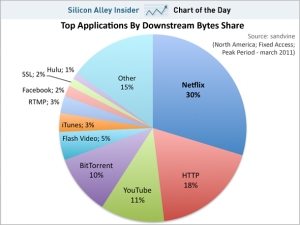I wondered when this would happen…
Of course, it was only a matter of time when these two events would occur! The first is running out of Internet addresses. The second is that streaming media (movies transmitted to your computer, from the cloud, in real time) now amount to the largest consumer of Internet traffic in North America.
A Shortage of Unique Internet Addresses
As of February of this year, all of the assignable Internet addresses available, have been assigned. That means that very shortly, there will be ‘no room on the Internet’ for new assignments – unless something changes. That change is a move from the IPV4 to IPV6 address schema.
“IPv4 and IPv6 are two different types of the Internet Protocol (as in IP address). IPv4 is the current standard and is used by the largest majority of systems that connect to a Local Area Network (LAN) and/or the World Wide Web.
IPv4 is only capable of holding four fields in an IP address. IPv6 is capable of holding six fields. One reason IPv6 has come into play is because, with the growing number of computers in the world, IPv4 will run out of possible combinations. There cannot be more than one device with an IP address otherwise it will cause conflicts.” Please take a look at a single-page PDF that compared IVP4 and IVP6 here.
We have known that we were consuming internet addresses far faster than anyone could have envisioned when the IVP4 address (TCPIP Protocol address standard was last revised in September, 1981).
Conventional wisdom is that the creators were only thinking about computing devices that would deliver information to a sitting user. They did not consider that a day would come when even a refrigerator in our home, or a traffic light on our streets, could take advantage of an Internet connection. The standard provided for four address fields. This results in a possible four billion addresses. IVP6 provides for six address fields. If you have six address fields you have a potential of 2 to the power of 128 and ends up being 340,282,366,920,938,000,000,000,000,000,000,000,000 unique IP addresses. That is a whole lot of potential and assignable addresses. Given what we know today, that should take us down the road for the foreseeable future.
There is a problem however. To implement the new standard, that need to be a massive hardware change, or running a parallel network (Internet 2) with switching between the two networks. This is a huge undertaking and will cost us all money!
How Internet Bandwidth is Used Today
 Roughly one third of the total Internet is being used to stream movies to your TV, from the Netflix Cloud. This startling news has been brought to us, once again, by Business Insider. In an article released today, they report that: “Netflix’s streaming service is so popular that it’s now consuming 30% of peak downstream internet bandwidth in North America, according to data from Sandvine, a broadband equipment company, via TechCrunch.
Roughly one third of the total Internet is being used to stream movies to your TV, from the Netflix Cloud. This startling news has been brought to us, once again, by Business Insider. In an article released today, they report that: “Netflix’s streaming service is so popular that it’s now consuming 30% of peak downstream internet bandwidth in North America, according to data from Sandvine, a broadband equipment company, via TechCrunch.
It is only after Netflix, that the main (and intended) HTTP (Hyper Text Transfer Protocol) traffic shows up with 18%, a little more than half of the 30% Netflix traffic. Are movie theaters going the way of the Music Industry, (soon) the Bookstore Industry, and may other information delivery institutions!
You can read more by going to the original article on Business Insider, and their data source TechCrunch. The times, they area changin’. If you can develop the skills to be a Technology Forecaster, you can provide a needed service, and become very rich in the process!
Read more: http://tiny.cc/fx6e1
Credit for some of the content in this post goes to an unknown poster on Yahoo Answers.


